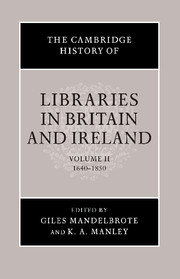Book contents
- Frontmatter
- 1 Introduction: the changing world of libraries – from cloister to hearth
- PART ONE THE EXPANSION OF BOOK COLLECTIONS 1640–1750
- PART TWO LIBRARY DEVELOPMENT AT A LOCAL LEVEL
- PART THREE PROVINCIAL AND METROPOLITAN LIBRARIES 1750–1850
- 18 Libraries in context: social, cultural and intellectual background
- 19 The book trade and libraries
- 20 Ecclesiastical libraries
- 21 Libraries in the parish
- 22 Books and universities
- 23 Libraries and literacy in popular education
- 24 Scientific and medical libraries: the rise of the institution
- 25 The first century of the British Museum library
- 26 The impact of the British Museum library
- 27 Private libraries in the age of bibliomania
- 28 Library architecture and interiors
- 29 Library management in the pre-professional age
- 30 Libraries for an imperial power
- 31 Engines of literature: libraries in an era of expansion and transition
- Select bibliography
- Index
- References
21 - Libraries in the parish
from PART THREE - PROVINCIAL AND METROPOLITAN LIBRARIES 1750–1850
Published online by Cambridge University Press: 28 March 2008
- Frontmatter
- 1 Introduction: the changing world of libraries – from cloister to hearth
- PART ONE THE EXPANSION OF BOOK COLLECTIONS 1640–1750
- PART TWO LIBRARY DEVELOPMENT AT A LOCAL LEVEL
- PART THREE PROVINCIAL AND METROPOLITAN LIBRARIES 1750–1850
- 18 Libraries in context: social, cultural and intellectual background
- 19 The book trade and libraries
- 20 Ecclesiastical libraries
- 21 Libraries in the parish
- 22 Books and universities
- 23 Libraries and literacy in popular education
- 24 Scientific and medical libraries: the rise of the institution
- 25 The first century of the British Museum library
- 26 The impact of the British Museum library
- 27 Private libraries in the age of bibliomania
- 28 Library architecture and interiors
- 29 Library management in the pre-professional age
- 30 Libraries for an imperial power
- 31 Engines of literature: libraries in an era of expansion and transition
- Select bibliography
- Index
- References
Summary
One book is my library’: the reply of an old woman in a Yorkshire Wolds village, that the Bible was all the library she had or wished to have.
Revd H.Woodcock, Piety among the peasantry (London, 1889), 214–15In a flurry of zealous Christian activity, Thomas Bray, amongst other achievements, brought about the founding of the Society for Promoting Christian Knowledge (SPCK) on 8 March 1699. Soon after, in 1705, a special committee for creating libraries was established with the title Trustees for Erecting Parochial Libraries and Promoting other Charitable Designs. By the time the Associates of Dr Bray was formed as a new management group, in 1729, the Trustees had established at least fifty-six parochial libraries in England and ten in Wales, each costing more than £20. Between 1753 and 1768 a further seventy parochial libraries and twelve lending libraries were founded by the Associates, though the scheme did not extend to Scotland, for which the SSPCK had been formed, also in 1699.
In its early years, the majority of the Associates’ book distribution activity focused on the needs of the Anglican clergy themselves, with piety and education as watchwords. Accordingly, books were chosen, packaged in wooden boxes and distributed to specific locations where it had been agreed that most need existed, with little or no opportunity for use by individual parishioners planned, or intended, by the Associates. Crucially, it seems that many of these nascent parochial libraries did eventually find their way into wider community use later in the century. The evidence offered by the few parish library loan records which survive suggests that overt attempts to open up use to the community and encourage public or, more specifically, parishioner access were often successfully made.
- Type
- Chapter
- Information
- The Cambridge History of Libraries in Britain and Ireland , pp. 324 - 344Publisher: Cambridge University PressPrint publication year: 2006



